On this page
GalápagosThis page lists books about birds and birdwatching on the Galápagos.The books are arranged by publication date with the most recent at the top of the page.
Galápagos species
For books about specific Galápagos birds see:
Darwin's Finches
EcuadorFor books about the birds of all of Ecuador see:
Ecuador
South AmericaFor books about all or a large part of South America see:
South America
PacificFor books about all or a large part of the Pacific Ocean see:
Pacific Ocean
|
|
|
|
Pocket Photo Guide: Birds of Ecuador and GalapagosClive Byers
Bloomsbury Pocket Photo Guides
Bloomsbury Publishing
2017
"Two hundred and fifty-two of Ecuador and the Galapagos' most interesting and spectacular birds are featured in this concise and easy-to-use guide. Illustrated with clear colour photography and brief but authoritative descriptions the Pocket Photo Guides highlight the species of birds and animals from each region that the traveller is most likely to see, as well as those that are genuinely endemic (only to be seen in that country or region) or special rarities. The genuine pocket size allow the books to be carried around on trips and excursions and will take up minimal rucksack and suitcase space."
|
Buy from amazon.co.uk 
|
|
Wildlife of the GalapagosJulian Fitter, Daniel Fitter and David Hosking
Collins Traveller's Guide
Harper Collins
2nd edition
2016
"This series of books is designed to give visitors to faraway places a handy identification guide to the wildlife they might see as they travel around the world. The fully updated and revised edition of this classic guide features a wealth of additional information, including a new 16-page section of visitor sites with maps, 85 additional species of fish and over 100 new photographs. Although perhaps best known for its Giant Tortoises, many other mammals, reptiles, coastal and marine life, birds, plants and invertebrates are also included. Illustrated with over 650 colour photographs, maps and drawings, it also includes information on the history, climate, geology and conservation of the islands. Featuring over 400 species of wildlife most likely to be encountered on a trip to these remote islands, this traveller’s guide is the ideal companion for anyone travelling to this fascinating region of the world."
|
Buy from amazon.co.uk 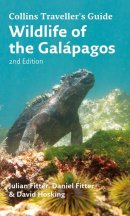
|
|
Galapagos Islands Bird GuideRobert Dean
Multilingual: English, Spanish, French, German
Rainforest Publications
2016
A 14 page laminated fold-out guide that provides an illustration and name in four languages plus the scientific name for 123 species.
|
 |
|
The Galapagos Hawk / El Gavilán de GalápagosTjitte de Vries
Bilingual: Spanish / English
Tundra Ediciones
2015
A monograph on the Galapagos Hawk. Chapters are: Origin And Formation Of The Islands; Each Island Is Different; Habitat Preferences Of The Galapagos Hawk; A Diurnal Predator And A Large Number Of Prey; Reproductive Biology; Social Life, Monogamy And Polyandry; The Tamest Hawk In The World; Relationship Between The Hawk And Two Owl Species; Origin Of The Galapagos Hawk, Morphology And Taxonomic Relations; Populations Dynamics; And In The Field, On The Island Of Santa Fe
|
Buy from amazon.co.uk 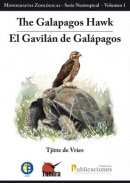
|
|
The Galápagos: A Natural HistoryHenry Nicholls
Profile Books
2014
"The Galapagos were once known to the sailors and pirates who encountered them as Las Encantadas: the enchanted islands, home to marvellous creatures and dramatic volcanic scenery. This captivating history of the world's most famous islands charts their evolution from deserted wilderness to profoundly important scientific resource and now global tourist destination. The Galapagos' rich diversity of species made it the cradle of evolutionary theory. Its scientific treasures have always been explored in surprising ways: Darwin rode on the back of tortoises, flung iguanas into the sea and attacked hawks with hats in the process of his discovery. And its lessons are far from exhausted: recently, Darwin's celebrated finches have helped biologists to film evolution in real time. The islands are famous throughout the world - recognition that brings with it 170,000 tourists a year and widespread development, as well as bitter clashes between environmentalists and local inhabitants. More than ever, we must be alert to the significance of this unique location - because what happens here foreshadows the fate of threatened ecosystems everywhere on earth."
|
Buy from amazon.co.uk 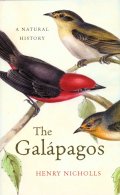
|
|
The Galapagos Marine Reserve: A Dynamic Socio-Ecological SystemEditor: Judith Denkinger, Luis Vinueza
Springer Verlag
2014
"This book focuses on how marine systems respond to natural and anthropogenic perturbations (ENSO, overfishing, pollution, tourism, invasive species, climate-change). Authors explain in their chapters how this information can guide management and conservation actions to help orient and better manage, restore and sustain the ecosystems services and goods that are derived from the ocean, while considering the complex issues that affect the delicate nature of the Islands. This book will contribute to a new understanding of the Galapagos Islands and marine ecosystems."
|
Buy from amazon.co.uk 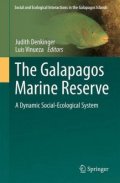
|
|
Fieldbook Of The Birds Of Ecuador, Including The Galapagos IslandsMiles McMullan and Lelis Navarrette
Foreword: Robert Ridgely
Fundacion de conservation Jocotoco
2013
"A new light and truly pocket-sized field guide for the bird-rich country of Ecuador. All of the birds of Ecuador and the Galapagos Islands are brought together in a single volume for the first time. With over 4,000 illustrations, many never before published, all major plumages for each species are illustrated and are accompanied with descriptions, identification notes, range maps, and notes on distribution and status. A percentage of the proceeds from the sale of this book go toward bird conservation in Ecuador."
|
Buy from amazon.co.uk 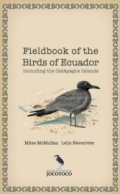
|
|
Evolution From The Galapagos: Two Centuries After DarwinEditor: Gabriel Trueba, Carlos Montúfar
Springer Verlag
2013
"This volume is a collection of the some of the most significant lectures that well-known experts presented at our two international 'summits on evolution' (2005, 2009) as updated and revised chapters. The meetings took place on one of the large islands of the Galapagos archipelago (San Cristobal) at GAIAS (Galapagos Institute for the Arts and Sciences) of the Universidad San Francisco de Quito (USFQ), Ecuador.? The main goal of the two Galapagos Summits on Evolution has been to bring together scientists and graduate students engaged in the study of evolution, from life's origin to its current diversity. Because of their historical significance, the Galapagos are a unique venue for promoting comprehensive research on evolution and ecology and to make the research results available to students and teachers everywhere, but especially from developing countries."
|
Buy from amazon.co.uk 
|
|
Science and Conservation in the Galapagos Islands: Frameworks & PerspectivesEditor: Stephen J. Walsh, Carlos F. Mena
Springer Verlag
2012
"In this launch of the Galapagos series, this book provides a broad 'framing' assessment of the current status of social and ecological systems in the Galapagos Islands, and the feedback that explicitly links people to the environment. It also highlights the challenges to conservation imposed by tourism in the Galapagos Islands and the attendant migration of people from mainland Ecuador to service the burgeoning tourism industry. Further, there is an emphasize on the status of the terrestrial and marine environments that form the very foundation of the deep attraction to the Islands by tourists, residents, scholars, and conservationists."
|
Buy from amazon.co.uk 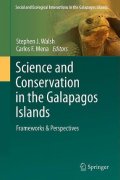
|
|
Galapagos: A Guide to the Animals and Plants / Guia de los animales y las plantas / Ein Tier-und PflanzenfuhrerNigel Sitwell
Wilmot Books
2011
Trilingual: Spanish / German / English
"Illustrated field guide to the most commonly seen wildlife on the Galapagos Islands. Includes birds, mammals, reptiles, and plants. Brief descriptions for each species accompany the detailed expert illustrations."
|
Buy from amazon.co.uk 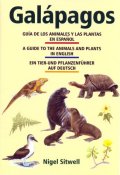
|
|
Galapagos WildlifeDavid Horwell and Pete Oxford
Bradt Wildlife Guides
Bradt
3rd edition
2011
"Travelling to the Galápagos to discover the unique flora and fauna that so captivated Darwin and the many that followed him is a rite of passage for serious wildlife enthusiasts. Written by two expert naturalists who are passionate about the Galápagos, this guide is packed with entertaining descriptions, while full-colour photography aids in identifying key species both on land and below water. Now with more detailed descriptions of island landing sites, more photos, and updated information on conservation efforts, Bradt's Galápagos Wildlife is the perfect companion for this once-in-a-lifetime trip. For those looking to explore it also includes unique island trail plans."
|
Buy from amazon.co.uk 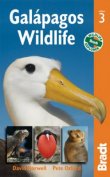
|
|
Ecuador and the Galapagos IslandsDavid L. Pearson and Les Beletsky
Travellers' Wildlife Guides
Arris Books
2nd edition
2010
"Provides the information needed to find, identify, and learn about Ecuador's magnificent animal and plant life. Contains illustrations on more than 500 of Ecuador's most common insects, amphibians, reptiles, birds, and mammals with accompanying information on identification, behaviour, habitats, common plants, and parks and reserves in the region. Contains magnificent colour plates illustrated by Priscilla Barrett, David Beadle, David Dennis, Dan Lane, John Myers, Colin Newman and John O'Neill."
|
Buy from amazon.co.uk 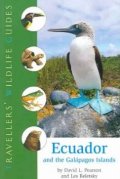
|
|
Darwin in Galápagos: Footsteps to a New WorldK. Thalia Grant & Gregory B. Estes
Princeton University Press
2009
"In 1835, during his voyage on HMS Beagle, Charles Darwin spent several weeks in Galápagos exploring the islands and making extensive notes on their natural history. Darwin in Galápagos is the first book to recreate Darwin's historic visit to the islands, following in his footsteps day by day and island by island as he records all that he observes around him. Thalia Grant and Gregory Estes meticulously retrace Darwin's island expeditions, taking you on an unforgettable guided tour. Drawing from Darwin's original notebooks and logs from the Beagle, the latest findings by Darwin scholars and modern science, and their own intimate knowledge of the archipelago, Grant and Estes offer rare insights into Darwin's thinking about evolution in the context of the actual locales that inspired him. They introduce Darwin as a young naturalist in England and onboard the Beagle and then put you in his shoes as he explores remote places in the islands. They identify the unique animals and plants he observed and collected, and describe dramatic changes to the islands since Darwin's time. They also explore the importance of Darwin's observations and collections to the development of his thinking after the voyage."
|
Buy from amazon.co.uk 
|
|
The Galapagos: Exploring Darwin's TapestryJohn Hess
University of Missouri Press
2009
"With an extensive background in ornithology and evolutionary ecology, a lifetime of experience as naturalist and photographer, and a deep respect for his subjects, John Hess has produced a celebration of these 'Enchanted Islands'. After describing the islands' origins and the complex of physical forces that make the Galapagos so remarkable, Hess turns his attention to the most prominent habitats on the islands and to the plants and animals encountered in them. He then focuses on the animals most encountered by visitors, animals that Hess presents as Galapagos Royalty: the flightless cormorant, the marine iguana, the Galapagos tortoise, and others.A photo essay for each of these species provides the reader with an intimate look at their physical and behavioral adaptations, and the accompanying text offers insight into their lives, showing that each of them is a unique and priceless evolutionary achievement."
|
Buy from amazon.co.uk 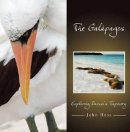
|
|
Galapagos: Preserving Darwin's LegacyTui De Roy
Christopher Helm
2009
"This gorgeous large-format book is a celebration of the 50th anniversary of the foundation of the Charles Darwin Foundation on Galapagos. The book comprises a series of invited essays under the editorship of world-renowned photographer and long-term Galapagos resident, Tui de Roy, who has also provided most of the photographs. The authoritative essays cover the entire spectrum of Galapagos wildlife."
|
Buy from amazon.co.uk 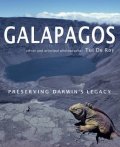
|
|
A Photographic Guide to Birds of Ecuador and GalapagosClive Byers
New Holland
1st edition
2009
"Although it is one of South America's smallest countries, Ecuador is home to nearly 1,600 species of birds. This is thanks to the huge variety of habitats created by the Andes. The country is a birder's paradise and an increasingly popular tourist destination. Areas such as Tandayapa, Mindo and La Selva are renowned for their birdwatching potential and boast such dramatic species as Toucan Barbet, Andean Cock-of-the-Rock, Andean Condor, Giant Conebill and Ocellated Tapaculo, plus an array of brightly coloured manikins, cotingas, tanagers and hummingbirds. Offshore, the Galapagos Islands provide one of the world's greatest wildlife spectacles.Two hundred and fifty-two of Ecuador and the Galapagos' most interesting and spectacular birds are featured in this concise and easy-to-use guide, with each illustrated in full colour with key information on ID, habitat and distribution."
|
Buy from amazon.co.uk 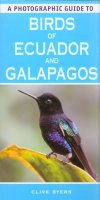
|
|
Galapagos: Both Sides of the CoinPete Oxford and Graham Watkins
Imagine Publishing
2009
"The two photographers have fashioned an unashamed celebration of the everyday life in the Galapagos that truly captures its essence and spirit. Every picture will leave readers awestruck and delighted: a sea lion mother with her baby; iguanas swimming in deep blue waters; a brilliantly-colored vermilion flycatcher resting on Spanish moss; a penguin atop Pinnacle Rock, surveying a magnificent landscape below. In addition, there's a spectacular record of the volcanic eruption of Fernandina in February 1995--one of the geological events fundamental to the archipelago's character. These stunning photos, as well as the compelling accompanying text and a map of the islands, will help us better understand the beauty and uniqueness of the Galapagos--and the importance of conserving its sanctity."
|
Buy from amazon.co.uk 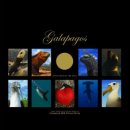
|
|
Wildlife of the GalapagosJulian Fitter, Daniel Fitter and David Hosking
Collins Traveller's Guide
Harper Collins
2007
"The islands of the Galapagos, situated off the coast of Ecuador in South America, are home to some of the world's most fascinating wildlife and are visited by thousands of tourists each year. This series is designed to give visitors to far-away places a handy identification guide to the wildlife they might see as they travel around. Featuring over 350 species of wildlife most likely to be encountered on a trip to these remote islands, this traveller's guide is the ideal companion for anyone travelling to this fascinating region of the world. Although perhaps best known for its Giant Tortoises, many other mammals, reptiles, coastal and marine life, birds, plants and invertebrates are also included. Illustrated with over 550 colour photographs, maps and drawings, it also includes maps of visitors' sites and information on the history, climate, geology and conservation of the islands."
|
Buy from amazon.co.uk 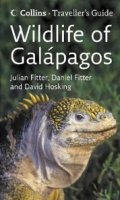
|
|
Galapagos: Photo Safari CompanionAlain Pons and Christine Baillet
Photo Safari Companion Series
Evan Mitchell Books
2007
"Galapagos, is, and no doubt always will be, associated with Darwin and his theories of evolution. These remote, volcanic islands remain home to more rare and extant plants and wildlife, on which he based his theories, than almost anywhere else on earth. For many years, these islands were off limits to all but a privileged few involved with science and research and, even today, the number of visitors is limited and controlled. For those who do go, there is an abundance of land animals, birds and sea-life, the best known being the land and sea iguanas and the giant tortoises. This book guides you along the best trails to find great photo opportunities."
|
Buy from amazon.co.uk 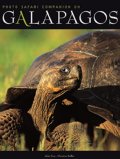
|
|
Birds, Mammals and Reptiles of the Galapagos IslandsAndy Swash and Robert Still
Christopher Helm
2nd edition
2006
"This compact, well thought out and clearly presented book provides a comprehensive guide to the terrestrial vertebrates on Galapagos. It is simple to use, the text is concise and the innovative use of digital technology has produced a remarkable collection of plates. An informative guide of this kind will help everyone, from beginner to experienced naturalist."
|
Buy from amazon.co.uk 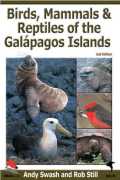
|
|
Galapagos: The Islands That Changed the WorldPaul D. Stewart
BBC Books
2006
"The Galapagos archipelago is made up of thirteen main islands and more than sixty other islets, rocks and reefs, scattered over four hundred kilometres of open ocean. Sitting at a confluence of four major ocean currents, the islands are actually the summits of vast undersea volcanoes, and are steadily on the march. How has such an odd assortment of life managed to find a footing in this unruly world? Micro-climates and altitude have combined to form discrete environmental zones: perfect habitats for the islands diverse fauna marine iguanas, petrels, blue-footed boobies and giant tortoises being but a famous few. Galapagos is a rare insight into an incredible landscape, a natural laboratory and an exquisite evolutionary habitat that Darwin described as a 'world within itself'. Both fragile and furious, the Galapagos is unlike any other place on earth."
|
Buy from amazon.co.uk 
|
|
Galápagos: A Natural HistoryJohn Kricher
Princeton University Press
2006
"John Kricher, a renowned ecologist and Galápagos ecotour guide, presents a detailed natural history of this spectacular archipelago. He looks at the amazing diversity of life found here, from iguanas to penguins, and explains the fascinating geology of these remote islands. Throughout his narrative, Kricher weaves the intriguing history of evolutionary biology that is intimately connected with the islands, and describes Darwin's adventures and observations while he was visiting in 1835. Indeed, Kricher takes his chapter titles from comments scattered throughout Darwin's account of his expedition around the world, The Voyage of the Beagle. Kricher closes his book by assessing the conservation efforts to preserve the Galápagos - and the challenges these efforts have met. Of special interest is the book's richly detailed island-by-island guide. For both the ecotraveler and the nature enthusiast, Galápagos is essential reading."
|
Buy from amazon.co.uk 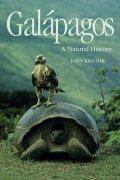
|
|
Galapagos: A Natural History GuidePierre Constant
Odyssey Passport Guides
2006
"This guide describes the rich human history, the geology and origin of the islands, the 'El Nino' phenomenon, the amazing natural history, villages and visitors' sites, and provides insights into the regions' fascinating residents - seabirds, endemic land birds, prehistoric reptiles, playful sea lions and the incomparably enchanting underwater world."
|
Buy from amazon.co.uk 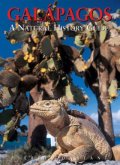
|
|
Ecuador and the Galapagos Islands: Traveller's Wildlife GuideDave L. Pearson and Les Beletsky
Roundhouse Publishing
2004
"In this book is all the information you need to find, identify, and learn about Ecuador's magnificent animal life. The authors, professional biologists, selected for color illustrations more than 500 of Ecuador's most common insects, amphibians, reptiles, birds, and mammals - the species you are most likely to see. In one easy-to-carry, entertainingly written, beautifully illustrated book, you will have as constant companion on your journey."
|
Buy from amazon.co.uk 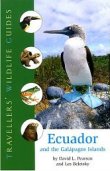
|
|
GalapagosJohn Kricher
Smithsonian Natural History Series
Smithsonian Books
2002
"John Kricher, a renowned ecologist and Galapagos ecotour guide, presents a detailed natural history of this spectacular archipelago. He looks at the amazing diversity of life found here, from flamingos to penguins, and explains the geology of these remote islands. Throughout his narrative, Kricher weaves the intriguing history of evolutionary biology that is intimately connected with the islands, and describes Darwin's adventures and observations while he was visiting the islands in 1835."
|
Buy from amazon.co.uk 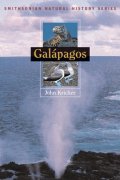
|
|
Evolution's Workshop: God and Science on the Galapagos IslandsEdward J. Larson
Allen Lane / Penguin
2001
"The central role played by the Galapagos Islands in this revolutionary moment eventually transformed that remote, seemingly desolate, archipelago into a sacred site for science and a place of tremendous interest to biologists and eco-tourists alike. The Islands came to be called "Darwin's Eden" and "The Galapagos Wonderland", but people have not always seen the archipelago that way. At nearly the same time that a young and impressionable Charles Darwin first began to comprehend its marvels, Herman Melville published ten sketches about his visit to the place, which he called "The Encantadas", or "Enchanted Isles", and for him it represented "evilly enchanted ground". Science exorcised the enchantments that seemed to hold the Galapagos Islands spellbound. And since Darwin the achipelago has in turn played an ever larger role in the history of science. That is the story told in this richly rewarding and deeply absorbing book. Pulitzer-Prize winner Edward Larson tells the tale of early British buccaneers and explorers; of Darwin's discoveries and post-Darwinian debates; of the fabulous expeditions of the Roaring Twenties, run in black-tie from rich men's yachts; of the struggle for control of research and efforts by creationists to use the Galapagos to undercut evolutionary theory; and of the growing threats to the archipelago's native environments. Inspired by this isolated island universe, Larson's history captures something of the grand, sweeping evolution of human understanding."
|
Buy from amazon.co.uk 
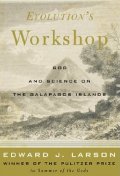

|
|
Ecuador and the Galapagos Islands: Traveller's Wildlife GuideDave L. Pearson and Les Beletsky
Arris
2001
"This book contains all the information you need to find, identify and learn about Ecuador's magnificent animal and plant life."
|
Buy from amazon.co.uk 
|
|
Collins Safari Guide: Wildlife of the GalapagosJulian Fitter, Daniel Fitter & David Hosking
Collins
2000
"Safari Guide Galapagos contains photographs and descriptions of over 200 species you are likely to encounter on a trip to these remote islands. It is the only wildlife guide you will need. Although perhaps best known for its Giant Tortoises, many other mammals, reptiles, coastal and marine life, birds, plants and invertebrates are also included. In addition, there is information on the history of the islands, climate, conservation, the Galapagos National Park and the volcanism of the area."
|
Buy from amazon.co.uk 
|
|
Birds, Mammals and Reptiles of the Galapagos IslandsAndy Swash and Robert Still
Pica
2000
"The first comprehensive photographic guide to all the birds, mammals and reptiles of the islands. Innovative, simple-to-use format for beginners or experts. Utilising latest digital photographic techniques, some of species never previously published. ID features, seasonal differences, status & habitat preferences. Colour distribution maps."
|
Buy from amazon.co.uk 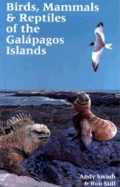
|
|
Galapagos: The Untamed IslesPete Oxford & Renee Bish
1999
"Adopting a fresh approach to Galapagos photography, Pete Oxford and Renee Bish have been gathering images for this book for over a decade. Although they have concentrated on everyday Galapagos events, some of the photographs in this magnificent collection are once in a lifetime shots."
|
Buy from amazon.co.uk 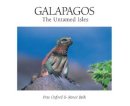
|
|
Ecuador and the Galapagos Islands: The Ecotraveller's Wildlife GuideDave L. Pearson and Les Beletsky
Academic Press
1999
"Ecotravellers to Ecuador want to experience tropical forest and other stunning habitats and catch glimpses of exotic wildlife, such as toucans and parrots, monkeys and anteaters, frogs and toads, crocodiles and snakes. On the Galapagos Islands, curious visitors want to see with their own eyes the exotic, unique and tame wildlife that stimulated Charles darwin to formulate the theory of evolution. This book provides the information you need to find, identify and learn about Ecuador's magnificent animal and plant life. The authors, professional biologists, selected for colour illustrations more than 500 of Ecuador's most common insects, amphibians, reptiles, birds, and mammals - the species you are most likely to see. In one easy-to-carry book, you will have as constant companion on your journey, information on identification, behaviour, habitats, common plants and parks and reserves in the region."
|
Buy from amazon.co.uk 
|
|
Galapagos Diary: A Complete Guide to the Archipelago's BirdlifeHermann Heinzel and Barnaby Hall
Christopher Helm
1998
"World famous bird illustrator Hermann Heinzel teamed up with a young photographer to capture the birds and other wildlife of these islands. The first section of the book is a tour around each of the islands describing in words, illustrations and photographs the habitats and wildlife to be found, highlighting some of the strange breeding strategies of the archipelago's birds with breathtaking illustrations. The second half of the book is a detailed field guide with sketches and more finished paintings, photographs and maps."
|
Buy from amazon.co.uk 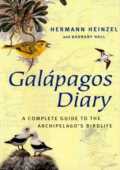
|
|
Galápagos: A Natural HistoryMichael H. Jackson
University of Calgary Press
2nd edition
1997
"An attractive & comprehensive guidebook, this work has been completely revised & updated by the author. The reader will find an easy-to-use text which details the natural history of the plants & animals found in the Galapagos Islands. Management & conservation of the Galapagos National Park is discussed, & visitor information & notes about the various tourist sites are given. An index & checklist of plants & animals with page references & a glossary of technical terms are provided."
|
Buy from amazon.co.uk 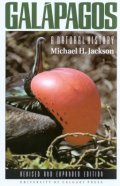
|
|
A Guide to Bird-Watching in Ecuador and the Galapagos IslandsBrinley J. Best, Tom Heijnen and Robert S. R. Williams
Biosphere Publications
1997
A guide to birdwatching areas.
|
Buy from amazon.co.uk 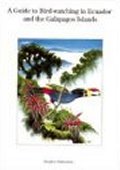
|
|
A Guide to the Birds of the Galapagos IslandsIsabel Castro and Antonia Phillips
Christopher Helm
1996
"The Galapagos Islands are renowned for their wildlife and the pioneering work undertaken by Charles Darwin in formulating his theories of natural selection and speciation. This guide covers and illustrates all the bird species to have been recorded on the islands."
|
Buy from amazon.co.uk 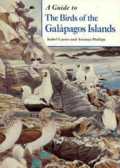
|
|
The Enchanted Islands: The Galapagos DiscoveredJohn Hickman
Anthony Nelson
1985
"The history of the Galapagos Islands from Inca times, which presents a cast of conquistadors, buccaneers, pirates, Robinson Crusoes and Swiss Family Robinsons; as well as eccentric explorers, hopeful colonists and naturalists, including the most famous of all - Charles Darwin."
|
Buy from amazon.co.uk 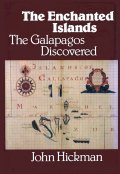
Buy from amazon.co.uk

|
|
Field Guide to the Birds of GalapagosMichael Harris
Illustrations: Barry Kent Mackay
Collins
1974
|
Buy from amazon.co.uk 
|
|
Galapagos: Islands Of BirdsBryan Nelson
Drawings: John Busby
Longmans
1968
|
Buy from amazon.co.uk 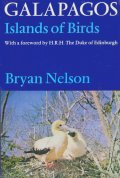
|
|
Birds of the Galapagos Archipelago
Robert Ridgway
Proceedings, Volume XIX
United States National Museum
1896
From the introduction: "While the present publication is intended to embody practically all that is known of the avifauna of the Galapagos archipelago, it does not claim to be exhaustive, for a great deal has yet to be learned before anything like a complete exposition of the subject is possible. Although our knowledge of the bird life of this interesting island group has been vastly increased since the publication of Darwin’s discoveries there, chiefly through the large collections made by Dr. Habel in 1868, the naturalists of the Albatross in 1888 and 1891, and Mcssrs. Baur and Adams m 1891, the information which has accumulated is still too fragmentary to warrant a serious attempt to solve the problems to which Mr. Darwin first called attention. Theories as to the origin of the Galapagoan fauna and related problems will therefore be briefly touched in the following pages, the principal object of the work being to collate the knowledge thus far secured and thereby facilitate future investigation in the field whose natural products afforded the basis of Darwin’s deductions concerning the complicated problems involve
|
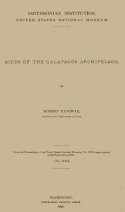
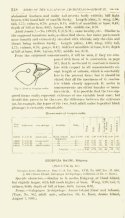
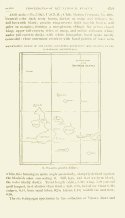 |
|
Descriptions Of Twenty-Two New Species Of Birds From The Galapagos Island
Robert Ridgway
Volume 17, pages 357-370
Proceedings Of The United States National Museum
1894
Opening lines: "The very large and valuable collection of Galapagos birds made by Dr. G. Baur and Mr. C. F. Adams, in 1891, was referred to me for determination of the species soon after the return of those gentlemen from their highly successful exploration of that remarkable island group, but various circumstances have prevented an earlier publication of the results of my study of the collection. Many of the specimens having been obtained on islands never before visited by a collector, it is to be expected that novelties would be found among the rich material which it has been my privilege to study. One box containing more than one hundred specimens of small birds collected on Charles, Hood, Barrington, and South Albemarle islands was unfortunately stolen at Guayaquil. Had these specimens been received, there can be no doubt that the number of new forms to be here characterized would be still greater."
|
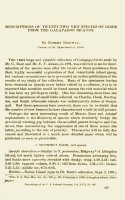 |
|
Scientific results of explorations by the U. S. Fish Commission steamer Albatross. No. I.. Birds collected on the Galapagos Islands in 1888
Robert Ridgway
Proceedings, Vol XII, pages 101-128
United States National Museum
1890
From the introduction to part I: "The collection of birds made by the Fish Commission Steamer Albatross having been placed by the Commissioner of Fisheries in my hands for identification and report, the following list of the species is herewith given, classified according to locality, and accompanied by such
notes as seem necessary or desirable. The collection was made by Prof Leslie A. Lee, naturalist of the expedition, assisted by Mr. Charles H. Townsend and Mr. Thomas Lee, and would doubtless have been much more extensive had not other duties, more closely connected with the main objects of the cruise, prevented"
|
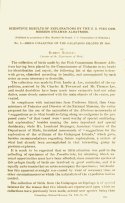 |
|
On The Avifauna Of The Galapagos Archipelago
Osbert Salvin
5 colour plates: J.G. Keulemans
Vol IX, Part IX
Transactions of the Zoological Society of London
1876
A paper from the Transactions of the Zoological Society of London.
From the opening lines: "In the volume of the Society's 'Proceedings' for 1870 Mr. Sclater and I published a brief summary of an important collection of birds made by Dr. Habel in the Galapagos Islands. The object of the present memoir is to give the particulars of that collection in greater detail, to incorporate the notes on the habits and other peculiarities of the birds drawn up by Dr. Habel himself, and to treat generally of the avifauna of this singular group of islands. To make my paper more complete I have added a short account of the history, structure, and physical features of the islands with regard to their bearing on the indigenous products. This account is drawn from the writings of various travellers; and to it I have added an account of his visit, furnished by Dr. Habel himself."
|
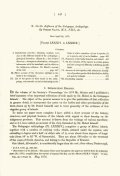
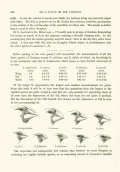
 |
|